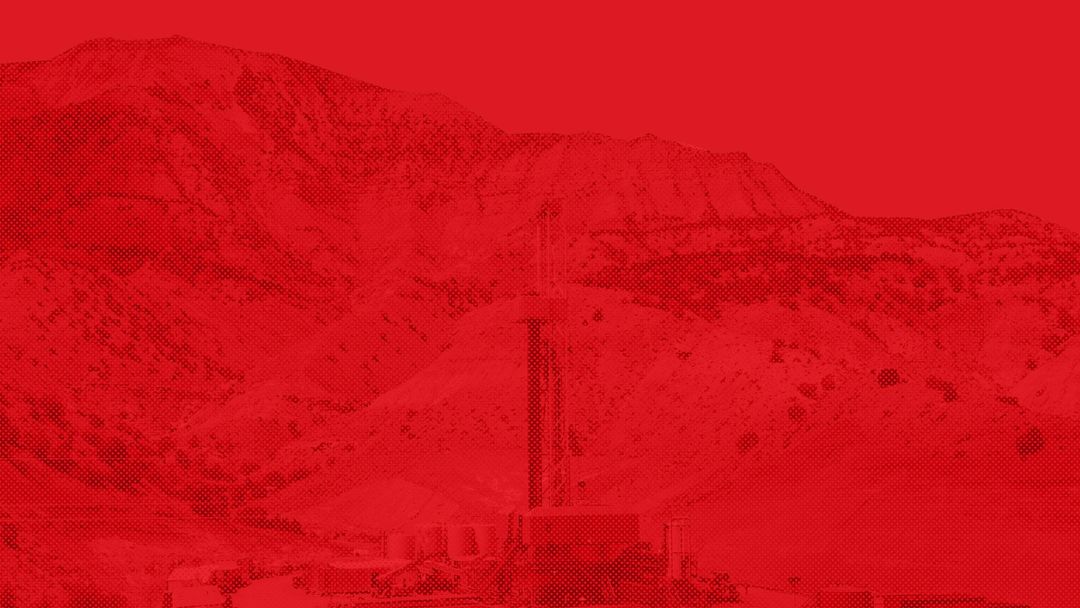Report
Lorem ipsum dolor sit amet, consectetur adipiscing elit. Suspendisse varius enim in eros elementum tristique. Duis cursus, mi quis viverra ornare, eros dolor interdum nulla, ut commodo diam libero vitae erat. Aenean faucibus nibh et justo cursus id rutrum lorem imperdiet. Nunc ut sem vitae risus tristique posuere.
26.01.23

The Carlyle Group’s Hidden Climate Impact:
Exposing a decade of fossil fuel investments
New report highlights that the Carlyle Group’s fossil fuel investments over the past decade have resulted in significant emissions of CO2 and other greenhouse gasses, exacerbating the global climate crisis and exposing institutional investors to transition risks.

The Carlyle Group stands out among large diversified private equity firms as having one of the largest energy portfolios, with most of it devoted to fossil fuels.
Carlyle’s lopsided energy portfolio has approximately $22.4 billion in carbon-based energy, and $1.4 billion (less than 1 percent of assets under management) committed to renewable and sustainable energy companies.
In other words, for every dollar it invested in renewable energy sources, Carlyle invested $16 in fossil fuels.
Exploiting regulatory exemptions and loopholes, private equity firms like Carlyle have become major greenhouse gas polluters, far away from public scrutiny and with minimal regulatory oversight. Private equity firms stand ready to swoop in and acquire polluting assets sold by publicly-listed companies under public and investor pressure to cut emissions from their operations. Furthermore, large institutional investors such as university endowments, philanthropic foundations, and public pension funds that have set ambitious decarbonization goals to mitigate climate risks in their portfolios are still heavily invested in private equity firms financing polluting assets.
Operating in the most opaque corners of the market, private equity firms have become a significant source of capital for companies engaged in the exploration, extraction, transportation, storage, processing and burning of oil, coal, and natural gas.
Energy investments did some heavy lifting for Carlyle’s profits in 2022, generating around half of the firm’s overall net income, mainly from over $660 million in investment income from NGP Energy, an oil and gas subsidiary.
This study pierces through the private equity veil of secrecy and finds that Carlyle invested billions of dollars in fossil fuel assets which have dumped at least 277 million metric tons of CO2 and other greenhouse gasses into the atmosphere from 2011 to 2021, contributing to the global climate crisis, and harming low-income communities and communities of color on a disproportionate basis.
Key findings over the ten-year period include:
From 2011 to 2021, Carlyle has invested in 91 energy companies owning 972 energy-related assets. Of those totals, 90 percent of the companies (82 companies) and 90 percent of the assets (872 assets) were fossil fuel investments. Renewable energy only accounted for a fraction of energy investments.
Carlyle’s fossil fuel investments across all energy sectors emitted an estimated 277 million metric tons of carbon dioxide equivalent (CO2e)—a measure that includes methane emissions and other powerful global-warming gasses—from 2011 to 2021. It would take 4.6 billion newly planted trees ten years to remove that much carbon.
Carlyle’s fossil fuel emissions increased at an average annual growth rate of 95 percent per year between 2011 and 2021.
Carlyle’s electricity generation is significantly dirtier than the US national production. Carlyle produced roughly ten times more electricity from fossil-fuels burning plants (146 megawatt-hours) than from renewable sources (15 megawatt-hours) from 2011 to 2021. During this same period, the US as a whole produced only four times more electricity from fossil fuels than from renewable sources.
Carlyle is currently a major owner of utility-scale electric power plants in the United States (US), with 11,240 megawatts (MW) of total capacity from a fleet of 17 natural gas plants (9,874 MW); two oil plants (42 MW); 66 solar facilities (712 MW); and six wind facilities (612 MW). Its natural gas fleet makes Carlyle one of the largest owners of gas-fired power capacity in the US, rivaling giants like Berkshire Hathaway Energy, NRG Energy, and the Tennessee Valley Authority.
Pollution from Carlyle’s current fossil fuel-burning power plants are emitted overwhelmingly in communities where residents of color and/or low-income residents live in higher concentrations than the respective state averages.
Close to half (47 percent) of Carlyle’s fossil fuel power plants have a record of environmental violations under its ownership, including facilities with repeated violations of the Clean Water Act, the Resource Conservation and Recovery Act, and the Clean Air Act.
Between 2011 and 2021, Carlyle-backed companies produced close to 1,300 million barrels of oil equivalent (mmboe) worth of oil and gas from upstream assets—mostly through oil and gas subsidiary NGP Energy. Of the total production, 65 percent was oil-based, while the remaining 35 percent was gas-based. This total production is equivalent to one-fifth of the yearly oil consumption in the US.

Carlyle’s energy portfolio is lopsided, making 94% of its energy investments in fossil fuels.
As of the end of 2022, Carlyle had $22.4 billion invested in carbon-based energy, and a self-reported $1.4 billion, less than 1 percent of its assets under management (AUM), committed to renewable and sustainable energy companies.
Private equity financial extraction poses additional risks for energy companies
Private equity firms manage funds from wealthy individuals and institutional investors, using this capital and high levels of debt to take over companies across various industries. These firms operate with limited regulation and transparency, making it difficult to assess the risks and impacts of their holdings. They exploit regulatory loopholes to generate high returns for executives, often at the expense of the target companies. By imposing fees, cutting costs, and engaging in aggressive risk-taking, private equity firms can jeopardize the financial stability of their portfolio companies. This often leads to an increased probability of bankruptcy, as seen during the 2020 oil price disruptions. Furthermore, private equity firms use complex legal structures to shield themselves from responsibility for financial, environmental, and community harm resulting from their short-term profit-driven practices.
Private equity: the only game in town for divested assets
Private equity’s stealth expansion in the fossil fuel sector has become an additional, unique obstacle to achieving emissions reductions. As public, investor and regulatory pressure tightens in public markets, utilities and major public companies are increasingly migrating their fossil fuel assets to less regulated ownership. These facilities continue operating, pumping warming gasses into the atmosphere away from public scrutiny and with minimal regulatory oversight.
“We ask ourselves, who’s going to own that stuff,” a Carlyle executive said. “By default, private equity is kind of the only game in town.”
Selling off their highest-polluting assets—instead of discontinuing them or phasing them out—to quickly wipe out tons of CO2 from their footprint allows the sellers to greenwash the public and peddle their “evolution as clean energy” companies or as “leader[s] in the zero-carbon transition,” as CEOs of major utilities have put it, while their emissions are merely transferred, not removed from the system entirely. “Yes, we finally unloaded that piece of crap in Denmark we’ve been trying to sell for decades,” a Shell executive wrote in an email about a refinery sold to a private equity firm, an exchange which Shell touted in a press release as “support[ing] our ambition to be a net-zero emissions energy business by 2050 or sooner.”
Private equity firms have emerged as “pollution financiers of last resort,” acquiring divested dirty assets. Divestment promises are also gaining momentum in academic endowments, philanthropic foundations, and state and local governments. But many of these institutional investors are still heavily invested in private equity, including in companies deep in polluting assets—like Carlyle.
Rhetoric vs reality: Carlyle’s climate double-speak
Carlyle’s investments in fossil fuels continue to expand even as globally, hundreds of billions of dollars are at risk from extreme weather damage, stranded assets and market disruptions as the climate crisis grows. Failure to mitigate the impacts of climate change would create billions in losses for pension funds, according to stress tests. At the same time, investment opportunities in the energy transition are growing. These trends mean investors with tens of trillions of dollars increasingly consider environmental risks an important factor for their capital allocations.


Lorem ipsum dolor sit amet, consectetur adipiscing elit. Nullam ac porta tortor. Phasellus eget justo molestie, rhoncus orci non, auctor diam. Etiam porttitor ligula ac augue tempor, non tincidunt nulla placerat. Proin in luctus elit. Fusce vel odio a purus volutpat iaculis sit amet quis enim. Nunc vehicula ornare iaculis. Aliquam odio eros, dapibus nec lacinia nec, laoreet sed mauris. Duis interdum tortor libero, vitae dapibus ipsum faucibus sed. In ex orci, hendrerit eget aliquam ut, ultricies volutpat metus.

THIS IS PAGE CONTENT SUB-HEADING
Nam sit amet tempor nisi, id ultrices enim. Sed sit amet mattis quam, id vestibulum enim. Cras aliquet in nisi ac dignissim. Aenean ligula tortor, auctor sed rhoncus nec, tristique quis tellus. Quisque sed justo a mauris commodo imperdiet in at erat. In lacus metus, hendrerit id quam et, fringilla scelerisque leo. Phasellus lobortis justo lacus. Suspendisse et orci sed turpis egestas pretium sed in dolor. Duis condimentum, nisi mattis fermentum tempor, tortor sem commodo turpis, sit amet fermentum velit orci molestie purus. Nunc porttitor velit et auctor gravida.
This is a block quote. Proin eget magna sed lacus cursus tristique dignissim ac odio. Donec facilisis dolor blandit erat mattis, quis consectetur nisi rhoncus.
Pellentesque finibus pellentesque sapien, sit amet sodales elit pretium ac. Aliquam eget nibh luctus nibh posuere tempus et ac ex. Morbi blandit magna sed ullamcorper faucibus. Mauris facilisis eget sapien eget convallis. Etiam ut dolor malesuada, bibendum purus sed, laoreet magna. Etiam eleifend elit nec massa scelerisque pulvinar. Nunc scelerisque enim sit amet quam gravida, sit amet lacinia nulla suscipit. Etiam lectus velit, iaculis ac dapibus in, efficitur non lacus. Duis vehicula arcu vitae mattis egestas. Aenean eget tellus vitae lorem ultricies sagittis sed id erat.
Quisque vel nisl tortor. Vestibulum fermentum feugiat risus id gravida. Pellentesque maximus dui ante, placerat vulputate purus condimentum sed. Ut et orci erat. Praesent scelerisque elementum augue, a gravida augue vestibulum ut. Vivamus et magna imperdiet, dapibus velit non, pellentesque tortor. Nullam tincidunt tincidunt ultricies. Sed maximus faucibus aliquam. Mauris pellentesque urna ut tristique pretium. Donec dignissim sed libero a hendrerit.

Private equity firms have invested over
$1 trillion
in energy since 2010, with the lion’s share in fossil fuels
Ten of the largest private equity buyout firms have the majority of their energy portfolios in
fossil fuels
Eight private equity firms collectively hold around
$216 billion
in energy, similar to the top 5 banks’ fossil fuel financing last year
In 2020, Blackstone’s power plants produced
18.1 million
metric tons of CO2 emissions
Power plants owned by Carlyle emitted
<1h3>0.8 million
metric tons of CO2 in 2020
Lorem ipsum dolor sit amet, consectetur adipiscing elit. Nullam ac porta tortor. Phasellus eget justo molestie, rhoncus orci non, auctor diam. Etiam porttitor ligula ac augue tempor, non tincidunt nulla placerat. Proin in luctus elit. Fusce vel odio a purus volutpat iaculis sit amet quis enim. Nunc vehicula ornare iaculis. Aliquam odio eros, dapibus nec lacinia nec, laoreet sed mauris. Duis interdum tortor libero, vitae dapibus ipsum faucibus sed. In ex orci, hendrerit eget aliquam ut, ultricies volutpat metus.
THIS IS PAGE CONTENT SUB-HEADING
Nam sit amet tempor nisi, id ultrices enim. Sed sit amet mattis quam, id vestibulum enim. Cras aliquet in nisi ac dignissim. Aenean ligula tortor, auctor sed rhoncus nec, tristique quis tellus. Quisque sed justo a mauris commodo imperdiet in at erat. In lacus metus, hendrerit id quam et, fringilla scelerisque leo. Phasellus lobortis justo lacus. Suspendisse et orci sed turpis egestas pretium sed in dolor. Duis condimentum, nisi mattis fermentum tempor, tortor sem commodo turpis, sit amet fermentum velit orci molestie purus. Nunc porttitor velit et auctor gravida.
“Pull out content or quote, mission statement ect here, large format text highlighted on page with a background colour”
Quotename or credit
Lorem ipsum dolor sit amet, consectetur adipiscing elit. Nullam ac porta tortor. Phasellus eget justo molestie, rhoncus orci non, auctor diam. Etiam porttitor ligula ac augue tempor, non tincidunt nulla placerat. Proin in luctus elit. Fusce vel odio a purus volutpat iaculis sit amet quis enim. Nunc vehicula ornare iaculis. Aliquam odio eros, dapibus nec lacinia nec, laoreet sed mauris. Duis interdum tortor libero, vitae dapibus ipsum faucibus sed. In ex orci, hendrerit eget aliquam ut, ultricies volutpat metus.
THIS IS PAGE CONTENT SUB-HEADING
Nam sit amet tempor nisi, id ultrices enim. Sed sit amet mattis quam, id vestibulum enim. Cras aliquet in nisi ac dignissim. Aenean ligula tortor, auctor sed rhoncus nec, tristique quis tellus. Quisque sed justo a mauris commodo imperdiet in at erat. In lacus metus, hendrerit id quam et, fringilla scelerisque leo. Phasellus lobortis justo lacus. Suspendisse et orci sed turpis egestas pretium sed in dolor. Duis condimentum, nisi mattis fermentum tempor, tortor sem commodo turpis, sit amet fermentum velit orci molestie purus. Nunc porttitor velit et auctor gravida.

The text here describes the image
And there is space for smaller text if we need to fit more in or a source for example

